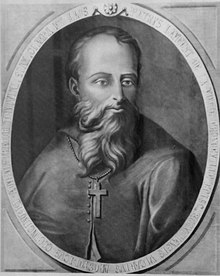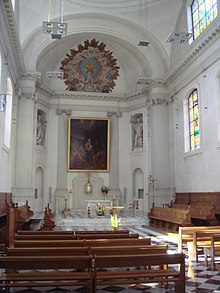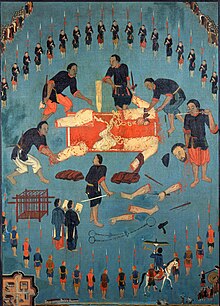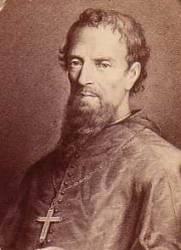Paris Foreign Missions Society
Société des Missions Etrangères de Paris[1] | |
 | |
| Abbreviation | Post-nominal letters: M.E.P.[1] |
|---|---|
| Formation | 1658 |
| Founder | Bishop François Pallu, MEP[2] |
| Type | Society of Apostolic Life of Pontifical Right (for Men) |
| Headquarters | 128 rue du Bac, 75341 Paris CEDEX 07, France[1] |
Membership | 189 members (178 priests) as of 2018[3] |
Superior General | Vincent Sénéchal[3] |
| Affiliations | Catholic Church |
| Website | https://missionsetrangeres.com/ |
The Society of Foreign Missions of Paris (
The Society of Foreign Missions of Paris was established 1658–63. In 1659, instructions for establishment of the Paris Foreign Missions Society were given by Rome's
In the 19th century, local persecutions of missionary priests of the Paris Foreign Missions Society were often a pretext for French military intervention in Asia.
Today, the Paris Foreign Missions Society remains an active institution in the evangelization of Asia.
Background

The traditional colonial powers of Spain and Portugal had initially received from the
From a territorial standpoint also, Portugal had been losing ground against the new colonial powers of England and the Dutch Republic, meaning that it was becoming less capable of evangelizing new territories.[9] In territories that it used to control, Portugal had seen some disasters; for instance, Japanese Christianity was eradicated from around 1620.[10]
Finally, Catholic officials had doubts about the efficacy of religious orders, such as the Dominicans, Franciscans, Jesuits or Barnabites, since they were highly vulnerable in case of persecutions. They did not seem able to develop local clergy, who would be less vulnerable to state persecution. Sending bishops to develop a strong local clergy seemed to be the solution to achieve future expansion:[10]
"We have all reason to fear that what happened to the Church of Japan could also happen to the Church of Annam, because these kings, in Tonkin as well as in Cochinchina, are very powerful and accustomed to war... It is necessary that the Holy See, by its own movement, give pastors to these Oriental regions where Christians multiply in a marvellous way, lest, without bishops, these men die without sacrament and manifestly risk damnation." Alexandre de Rhodes.[10]
As early as 1622
In the field, violent conflicts would erupt between the Padroado and the Propaganda during the 17th and 18th centuries.[8] (When the first missionaries of the Paris Foreign Missions Society were sent to the Far East, the Portuguese missionaries were ordered to capture them and send them to Lisbon).[12] The creation of the Paris Foreign Missions Society was well-aligned with Rome's efforts to develop the role of the Propaganda.[13]
Establishment

The creation of the Paris Foreign Missions Society was initiated when the Jesuit priest
Due to the strong opposition of Portugal and the death of Pope Innocent X the project was stalled for several years however, until the candidates to the missions decided to go by themselves to Rome in June 1657.[9]
Appointment of missionary Bishops


On 29 July 1658, the two chief founders of the Paris Foreign Missions Society were appointed as bishops in the
All of them were nominated Bishops
The Society itself ("Assemblée des Missions") was formally established by the Compagnie du Saint-Sacrement in 1658.[23] The object of the new society was and is still the evangelization of non-Christian countries, by founding churches and raising up a native clergy under the jurisdiction of the bishops. The Society was officially recognized in 1664.[24] The creation of the Paris Foreign Missions Society coincided with the establishment of the French East India Company.

In order to dispatch the three missionaries to Asia, the Compagnie du Saint-Sacrement established a trading company (the "Compagnie de Chine", founded 1660). A ship, the Saint-Louis, was built in the Netherlands by the shipowner Fermanel, but the ship foundered soon after being launched.[25] At the same time, the establishment of a trading company and the perceived threat of French missionary efforts to Asia was met with huge opposition by the Jesuits, the Portuguese, the Dutch and even the Propaganda, leading to the issuing of an interdiction of the Compagnie du Saint-Sacrement by Cardinal Mazarin in 1660.[26] In spite of these events, the King, the Assembly of the French Clergy, the Compagnie du Saint-Sacrement and private donors accepted to finance the effort, and the three bishop managed to depart, although they now had to travel on land.[26]
The three bishops chosen for Asia left France (1660–62) to go to their respective missions, and crossed
Founding principles

The mission had the objective of adapting to local customs, establishing a native
"Here is the principal reason which determined the Sacred Congregation to send you as Bishops in these regions. It is that you endeavour, by all possible means and methods, to educate young people so as to make them capable of receiving
priesthood."— Extract from the 1659 Instructions, given to Pallu and Lambert de la Motte by the Sacred Congregation for the Propagation of the Faith.[27]
Instructions were also given to the effect that respecting the habits of the countries to be evangelized was paramount, a guiding principle of the missions ever since:
"Do not act with
zeal, do not put forward any arguments to convince these peoples to change their rites, their customs or their usages, except if they are evidently contrary to the religion and morality. What would be more absurd than to bring France, Spain, Italy or any other European country to the Chinese? Do not bring to them our countries, but instead bring to them the faith, a faith that does not reject or hurt the rites, nor the usages of any people, provided that these are not distasteful, but that instead keeps and protects them."— Extract from the 1659 Instructions, given to Pallu and Lambert de la Motte by the Sacred Congregation for the Propagation of the Faith.[28]
Establishment on Rue du Bac, Paris



The Seminary (Séminaire des Missions Étrangères) was created in March 1663.
The seminary was established so that the society might recruit members and administer its property, through the actions of the
Known from the beginning as the Seminary of Foreign Missions, it secured the approval of Pope Alexander VII, and the legal recognition of the French Government and Louis XIV in 1663. In 1691 the chapel was established, and in 1732 the new, larger, building was completed.[23]
Another wing, perpendicular to the 1732 one, was added in the 19th century to accommodate the great increase in members of the Seminary.
1658–1800
The chief events of this period were: the publication of the book Institutions apostoliques, which contains the germ of the principles of the rule, the foundation of the general seminary in
Siam

The Paris Foreign Missions Society started its work in
The missionary work also had political effects: through their initiative a more active trade was established among Indo-China, the
In 1702, Artus de Lionne, Bishop of Rosalie, and missionary of the Paris Foreign Missions Society, brought Arcadio Huang to France as one of the first Chinese men there. He established the basis for the study of the Chinese language in France.
In the second half of the 18th century, the society was charged with the missions which the Jesuits had possessed in India prior to suppression of the order in Portugal. Many of the Jesuits remained in Asia. The missions took on a new life, especially in Sichuan (see Catholic Church in Sichuan), under bishops Pottier and Dufresse, and in Cochinchina.
Cochinchina
In Cochinchina,
French revolution
At the end of the 18th century, the French Revolution halted the growth of the society, which had previously been very rapid. At that time it had six bishops, a score of missionaries, assisted by 135 native priests; in the various missions there were nine seminaries with 250 students, and 300,000 Christians.[7] Each year the number of baptisms rose on an average of 3000 to 3500; that of infant baptisms in articulo mortis was more than 100,000.
Nineteenth century
On 23 March 1805, Napoleon signed a decree reinstating the Paris Foreign Missions Society.[34] In 1809 however, following a conflict with the Pope, Napoleon cancelled his decision. The Missions would be firmly re-established through a decree by Louis XVIII in March 1815.[35]
Several causes contributed to the rapid growth of the society in the 19th century; chiefly the charity of the Propagation of the Faith and the


The second cause was persecution. Fifteen missionaries died in prison or were beheaded during the 17th and 18th centuries and the beginning of the 19th century; but after that those killed among the missionaries were very numerous. (See Martyr Saints of China). Altogether, about 200 MEP missionaries died of violent death. Among them 23 were beatified, of whom 20 were canonized,[36] with an additional 3 in 2000.
Authors such as
By 1820, the territory of the Missions, which included India since the prohition of the
In the 19th century, the local persecutions of missionary priests of the Paris Foreign Missions Society was often a pretext for French military intervention in Asia,
Another cause of the progress of the missionaries was the ease and frequency of communication in consequence of the invention of steam and the opening of the
Vietnam

In 1825, emperor
Ming Man's successor, Thiệu Trị, upheld the anti-Catholic policy of his predecessor. In 1843, the French Foreign Minister François Guizot sent a fleet to Vietnam under Admiral Jean-Baptiste Cécille and Captain Charner,.[39] The action also was related to the British successes in China in 1842, and France hoped to be able to establish trade with China from the south. The pretext was to support British efforts in China, and to fight the persecution of French missionaries in Vietnam.[40]
In 1847, Cécille sent two warships (Gloire and Victorieuse) under Captain Lapierre to Da Nang (Tourane) in Vietnam to obtain the release of two imprisoned French missionaries, Bishop Dominique Lefèbvre (imprisoned for a second time as he had re-entered Vietnam illegally) and Duclos, and freedom of worship for Catholics in Vietnam.[39][41] As negotiations drew on without results, on April 15, 1847, a fight named the Bombardment of Đà Nẵng erupted between the French fleet and Vietnamese ships, three of which were sunk as a result. The French fleet sailed away.[41]
Other missionaries were martyred during the reign of Emperor

Ten martyrs of the M.E.P. were canonized by
- François-Isidore Gagelin (1833)
- Joseph Marchand (1835)
- Jean-Charles Cornay (1837)
- François Jaccard (1838)
- Bishop Pierre Borie, vicar apostolic of Western Tonking (1838)
- Augustin Schoeffler (1851)
- Jean-Louis Bonnard (1852)
- Pierre-François Néron (1860)
- Théophane Vénard (1861)
- Bishop Étienne-Théodore Cuenot, vicar apostolic of Eastern Cochinchina (1861)
-
Native priests of the Paris Foreign Missions Society, in western Tonkin.
-
Jules Paspin, of the MEP. Died of malnutrition in Vietnam in 1856.
Korea

In the mid-19th century that the first western Catholic missionaries began to enter Korea. This was done by stealth, either via the Korean border with Manchuria or the Yellow Sea. These French missionaries of the Paris Foreign Missions Society arrived in Korea in the 1840s to proselytize to a growing Korean flock that had in fact independently introduced Catholicism into Korea but needed ordained ministers.
1839 persecutions
On 26 April 1836,
1866 persecutions
Bishop

In January, 1866 Russian ships appeared on the east coast of Korea demanding trading and residency rights in what seemed an echo of the demands made on China by other western powers. Native Korean Christians, with connections at court, saw in this an opportunity to advance their cause and suggested an alliance between France and Korea to repel the Russian advances, suggesting further that this alliance could be negotiated through Bishop Berneux. The Heungseon Daewongun seemed open to this idea, though it is uncertain whether this was ruse to bring the head of the Korean Catholic Church out into the open. Berneux was summoned to the capital, but upon his arrival in February 1866, he was seized and executed. A roundup then began of the other French Catholic priests and native converts.
As a result of the Korean dragnet all but three of the French missionaries were captured and executed: among them were Siméon Berneux, Antoine Daveluy, Just de Bretenières,
Ten martyrs of the M.E.P. were canonized by John-Paul II, 6 May 1984, as part of 103 canonized martyrs of Korea, including André Kim Tegong, the first Korean priest, and 92 Korean laics:
- Bishop Laurent Imbert (21 September 1839)
- Pierre Maubant (21 September 1839)
- Jacques Chastan (21 September 1839)
- Bishop Siméon Berneux (8 March 1866)
- Just de Bretenières (8 March 1866)
- Louis Beaulieu (8 March 1866)
- Pierre-Henri Dorie (8 March 1866)
- Bishop Antoine Daveluy (30 March 1866)
- Pierre Aumaître (30 March 1866)
- Martin-Luc Huin (30 March 1866)
China



Auguste Chapdelaine, who was preaching illegally in China, was imprisoned, tortured and killed by Chinese authorities in 1856. This event, named the "Father Chapdelaine Incident" became the pretext for the French military intervention in the Second Opium War.[48][49][50]
Three missionaries of the M.E.P. were canonized by Pope
- Bishop Gabriel-Taurin Dufresse, Vicar Apostolic of Szechwan, martyred in Chengdu (1815)
- Auguste Chapdelaine, martyred in Guangxi (29 February 1856)
- Jean-Pierre Néel, martyred in Guizhou (1862)
-
Gabriel-Taurin Dufresse, martyred in Chengdu in 1815.
-
Pierre Dumont, died fleeing a Muslim revolt in Yunnan in 1856.
-
Auguste Chapdelaine, martyred in Guangxi in 1856.
-
Jean-Pierre Néel, martyred in Guizhou in 1862.
Japan

After the suppression of Christianity in Japan from around 1620 and nearly two century of strictly enforced seclusion thereafter, various contacts occurred from the middle of the 19th century as France was trying to expand its influence in Asia. After the signature of the Treaty of Nanking by Great Britain in 1842, both France and the United States tried to increase their efforts in the Orient.
The first attempts at resuming contacts occurred with the

Forcade and Ko were picked up to be used as translators in Japan, and Leturdu was left in Tomari, soon joined by Mathieu Adnet. On July 24, 1846, Admiral Cécille arrived in
France would have no further contacts with Okinawa for the next 7 years, until news came that Commodore Perry had obtained an agreement with the islands on July 11, 1854, following his treaty with Japan. France sent an embassy under Rear-Admiral Cécille onboard La Virginie in order to obtain similar advantages. A convention was signed on November 24, 1855.
As contacts between France and Japan developed during the Bakumatsu period (on the military side this is the period of the first French military mission to Japan), Japan was formed into a unique Vicariate Apostolic from 1866 until 1876. The Vicariate was administered by Bernard Petitjean, of the Paris Foreign Missions Society (1866–1884).[2]
20th century
The following table shows the state of the missions at the turn of the 20th century:[2]
Missions of Japan and Korea
Total numbers
|
Missions of China and Tibet
Total numbers
|
Missions of Eastern Indo-China
Total numbers
|
Missions of Western Indo-ChinaTotal numbers
|
Missions of India
Total numbers
|
A
Exhibits
The
Another, much larger, exhibition is located on the ground floor of the main building of the Paris Foreign Missions Society. Established as a temporary exhibition in 2007–2008, it remains in place but is now closed to the general public. It is only opened for visits once a year during the free-access "Journée des Musées Nationaux", although there seem to be plans to make it a permanent exhibition in the near future.
-
Portrait of Vietnamese crown prince Nguyễn Phúc Cảnh.
-
Ashes ofPigneau de Behaine.
-
Pigneau's 1772 Dictionarium Anamitico-Latinum.
-
The Society in 1925.
The park


The park of the Paris Foreign Missions Society is the largest private garden in Paris. It houses various significant artifacts, such as a Chinese bell from Canton brought to France by the French Admiral Charles Rigault de Genouilly, a stela to Korean Martyrs and the list of canonized members of the Paris Foreign Missions Society. The park can be visited every Saturday at 15:30.
The French writer
"As I write these last words, my window, which looks west over the gardens of the Foreign Mission, is open: it is six in the morning; I can see the pale and swollen moon; it is sinking over the spire of the
Invalides, scarcely touched by the first golden glow from the East; one might say that the old world was ending, and the new beginning. I behold the light of a dawn whose sunrise I shall never see. It only remains for me to sit down at the edge of my grave; then I shall descend boldly, crucifix in hand, into eternity."— Chateaubriand Mémoires d'Outre-Tombe Book XLII: Chapter 18[56]
See also
- Timeline of Christian missions
- Catholic religious order
- Society of Saint-Sulpice
- Catholic Church in Asia
- Christianity in Asia
- Chinese Rites controversy
- Category:Paris Foreign Missions Society
- Former French Mission Building in Hong Kong
Notes
- ^ a b c "Paris Foreign Missions Society (M.E.P.)". GCatholic.org.
- ^ a b c d e f
 One or more of the preceding sentences incorporates text from a publication now in the public domain: Herbermann, Charles, ed. (1913). "Society of Foreign Missions of Paris". Catholic Encyclopedia. New York: Robert Appleton Company.
One or more of the preceding sentences incorporates text from a publication now in the public domain: Herbermann, Charles, ed. (1913). "Society of Foreign Missions of Paris". Catholic Encyclopedia. New York: Robert Appleton Company.
- ^ a b "Paris Foreign Missions Society (M.E.P.)".
- ^ a b Asia in the Making of Europe, p.231
- ^ Missions, p.3
- ^ a b c d e f Missions, p.4
- ^ a b c d e Missions, p.5
- ^ a b c Mantienne, p.22
- ^ a b Les Missions étrangères, p.30
- ^ a b c Les Missions Etrangères, p.25
- ^ Mantienne, p.23
- ^ Asia in the Making of Europe, p.232
- ^ a b Mantienne, p.26
- ^ Missions, p.3-4
- ^ Mantienne, p.26-28
- ^ Asia in the Making of Europe, p.232
- ^ Viet Nam By Nhung Tuyet Tran, Anthony Reid p.222
- ^ An Empire Divided by James Patrick Daughton, p.31
- ^ Asia in the Making of Europe, p.229-230
- ^ a b c Les Missions Etrangeres, p.35
- ^ Institutional Culture in Early Modern Society By Anne Goldgar, Robert I. p.25 Note 77 [1]
- ^ A Bibliography of Canadian Imprints, 1751–1800 by Marie Tremaine p.70 [2]
- ^ a b c Mantienne, p.29
- ISBN 9780190677602. Page 27.
- ^ Mantienne, p.28
- ^ a b Asia in the Making of Europe, p.232
- ^ Les Missions Etrangères, p.37. Original French "Voici la principale raison qui a déterminé la Sacrée Congrégation à vous envoyer revêtus de l'épiscopat dans ces régions. C'est que vous preniez en main, par tous les moyens et méthodes possibles, l'éducation de jeunes gens, de façon à les rendre capable de recevoir le sacerdoce."
- ^ Missions, p.5. Original French: "Ne mettez aucun zèle, n'avancez aucun argument pour convaincre ces peuples de changer leurs rites, leurs coutumes et leur moeurs, à moins qu'ils ne soient évidemment contraires à la religion et à la morale. Quoi de plus absurde que de transporter chez les Chinois la france, l'Espagne, l'Italie, ou quelque autre pays d'Europe? N'introduisez pas chez eux nos pays, mais la foi, cette foi qui ne repousse ni ne blesse les rites, ni les usages d'aucun peuple, pourvu qu'ils ne soient pas détestables, mais bien au contraire veut qu'on les garde et les protège."
- ^ The Cambridge History of Southeast Asia By Nicholas Tarling, p.191
- ^ Asia in the Making of Europe, p.249
- ^ a b Les Missions Etrangeres, p.54
- ^ Les Missions Etrangeres, p.45
- ^ New Terrains in Southeast Asian History, p.294, Abu Talib
- ^ Les Missions Etrangeres, p.135. Article No1 of the decree: "Les établissements des Missions, connus sous la dénomination des Missions étrangères, et le séminaire du Saint-Esprit sont rétablis".
- ^ Les Missions Etrangeres, p.135
- ^ Website of the College General: [3] Archived 2008-07-22 at the Wayback Machine
- ^ Les Missions Etrangeres, p.137
- ^ Dragon Ascending By Henry Kamm p.86
- ^ a b Chapuis, p.5 Google Books Quote: "Two years later, in 1847, Lefebvre was again captured when he returned to Vietnam. This time Cecille sent captain Lapierre to Da Nang. Whether Lapierre was aware or not that Lefebvre had already been freed and on his way back to Singapore, the French first dismantled masts of some Vietnamese ships. Later on April 14, 1847, in only one hour, the French sank the last five bronze-plated vessels in the bay of Da Nang.
- ^ Tucker, p.27
- ^ a b Tucker, p.28
- ^ Les Missions Etrangeres, p.12
- ^ Tucker, p.29
- ^ A History of Vietnam, Oscar Chapuis p.195
- ^ Tucker, p.29
- ^ Source
- ^ "It is estimated than 10,000 were killed within a few months" Source Archived 2007-06-10 at the Wayback Machine
- ^ Religion Under Socialism in China by Zhufeng Luo, Chu-feng Lo, Luo Zhufeng p.42: "France started the second Opium War under the pretext of the "Father Chapdelaine Incident." [4]
- ^ Taiwan in Modern Times by Paul Kwang Tsien Sih p.105: "The two incidents that eventually caused a war were the Arrow incident and the murder of the French Catholic priest, Abbe Auguste Chapdelaine"
- ^ A History of Christian Missions in China p.273 by Kenneth Scott Latourette: "A casus belli was found in an unfortunate incident which had occurred before the Arrow affair, the judicial murder of a French priest, Auguste Chapdelaine" [5]
- ^ The Dublin Review, Nicholas Patrick Wiseman [6]
- ISBN 0-521-55028-9, p.162
- ^ Restoration of Béthanie: now the home of Emmanuel Church - Pokfulam, Hong Kong
- ISBN 978-988-99438-0-6
- ^ "The history of Nazareth which was previously known as Douglas Castle and is now University Hall". Archived from the original on 2018-05-08. Retrieved 2011-10-21.
- ^ Chateaubriand Mémoires d'Outre-Tombe Book XLII: Chapter 18
References
- Mantienne, Frédéric (1999) Monseigneur Pigneau de Béhaine (Eglises d'Asie, Série Histoire, ISSN 1275-6865) ISBN 2-914402-20-1
- Missions étrangères de Paris. 350 ans au service du Christ 2008 Editeurs Malesherbes Publications, Paris ISBN 978-2-916828-10-7
- Les Missions Etrangères. Trois siècles et demi d'histoire et d'aventure en Asie Editions Perrin, 2008, ISBN 978-2-262-02571-7
Further reading
- Adrien Launay (1898) Histoire des missions de l'Inde, 5 vols.










